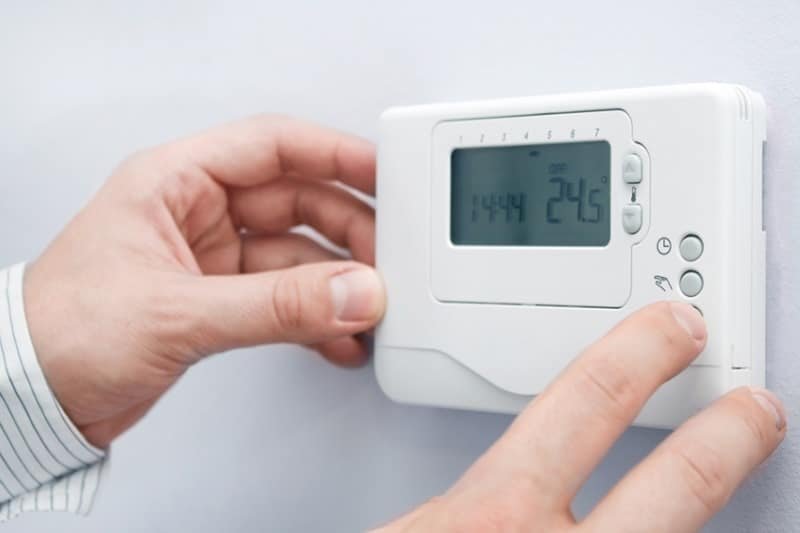With recent technological advancements, it is only fair to say that the days of rotating a dial on a manual thermostat are up. Instead, we are in the age of programmable and smart thermostats, which have kicked off a different ball game. If you are looking for an upgrade for your home but want to check out all your choices prior to hitting the market, this guide is here to help you make up your mind.
A thermostat is an intelligent piece of gadget that helps regulate indoor temperature while allowing efficient and effective operation of the cooling and heating systems. While the basic functionality remains the same, many other features set the programmable thermostat apart from the smart one. If you are interested in learning what a smart thermostat does and how it is different from a programmable one, keep reading.
What Is a Programmable Thermostat?
A programmable thermostat allows you to pre-determine your home’s temperature using the scheduling features for up to seven days. These thermostats typically come with pre-set schedules like morning, at work, bedtime, etc. Usually, they have a simple interface, and the programming is done using on-device controls and touch screen at times.
In addition, it helps to optimize energy usage by letting you customize the temperature settings so that the HVAC system runs only when required. So let’s assume if you have to leave for work while your kids are at school, the programmable thermostat can be set to adjust the temperature so that it doesn’t run unnecessarily.
What Is a Smart Thermostat?
A smart thermostat is a more advanced version of a programmable thermostat. Some models even utilize machine learning algorithms and artificial intelligence for its decision-making process. This type of thermostat can learn the user’s preferences and behaviors and adjust the temperature automatically. In addition, a smart thermostat with motion sensors can detect the presence of the users and optimize usage depending on the occupancy.
Moreover, smart thermostats offer remote control over WiFi. You can set schedules, geofencing, vacation mode and much more just by a few taps on your phone. Smart thermostats are known for their energy-saving capabilities and are especially useful for people who travel frequently or have changing schedules.
Key Differences in Programmable vs Smart Thermostat
Both types of thermostats can make life easier and save money on energy bills, but one type of device might be a better fit for your lifestyle. Here’s what sets both of them apart and decide which is the best option for you and your home.
1. Learning Ability
One of the biggest advantages and differences the smart thermostat has is its energy-saving features that, when utilized efficiently, can help reduce utility costs to a much greater extent. This includes its learning capabilities of the thermostat for automatically adjusting the temperature according to the users’ needs and preferences. In addition, some smart thermostats even have occupancy sensors that make a decision upon detecting people in the room.
2. Remote Access
Smart thermostats can be controlled via your mobile from anywhere, offering greater control and convenience. All you are required to do is install the respective app with your thermostat and register yourself. Not only can you turn your HVAC system on and off, but you can do a lot more, like changing the temperature, mode, monitor usage, etc.
As for a programmable thermostat, you have to be present in your home to make any changes. It is usually done via the touchscreen on the device or from the on-device controls.
3. Adjustment for Environmental Conditions
Another difference is the programmable thermostat’s limited capability to cater to the changes in the external environment. Several factors contribute to an HVAC system’s efficiency, like changing weather conditions. A programmable thermostat falls short when accounting for all these factors.
On the contrary, a smart thermostat can maximize the efficiency of your HVAC system by adjusting for some of the crucial external factors. For instance, fluctuating weather conditions and humidity levels. Devices like Cielo Smart Thermostat factor in local weather data and adjust your home temperature automatically.
4. Synthesize Real-Time Energy Usage Data
Smart thermostats offer more advanced analytics and reporting than programmable thermostats. They allow tracking energy usage, identifying patterns and trends, and creating personalized energy-saving plans. Moreover, some smart thermostats have a real-time energy dashboard that allows users to see how much energy is consumed. They monitor energy data to carry out data-driven decisions that positively affect energy efficiency.
Smart thermostats are also more convenient as they can be controlled remotely. This means you can monitor and adjust the temperature at home without the restriction of being present there. It is greatly valuable for users who work and have irregular schedules, and at the same time, it is important to maintain the comfort level at home for the family or even pets.
5. Flexibility for Varied Lifestyle
It may vary depending on the brand and model, but smart thermostats generally provide more flexibility and convenience in scheduling options. While programmable thermostats usually come with 4-5 pre-set scheduling options, a smart thermostat can allow you to set more.
For example, Cielo’s newly launched smart thermostat enables you to set up to 20 schedules. You can set custom schedules for each day of the week and save them under different presets like home, away, pet, sleep etc.
6. Initial Cost
There is a steep price difference between the two types of thermostats. You can purchase a programmable thermostat within the range of $60-$100. Conversely, a smart thermostat can be a little pricey. Depending on which thermostat you opt for, you might have to pay around $160 or even more for it. Nonetheless, if you do your research well, there are a few smart thermostat options in the market that you can get without breaking the bank.
Also, even though the initial price might seem a little overwhelming, considering the long-term benefits of a smart thermostat can help you become more energy-efficient.
Conclusion: Is a Smart Thermostat Worth Buying?
In conclusion, a smart thermostat and a programmable thermostat both make good investments for your home. They are both designed keeping in mind your convenience and energy savings. The main difference lies in technological capabilities. A smart thermostat can do everything a programmable one does while going above and beyond.
With that said, switching to the smart one might be unnecessary if you already own a programmable thermostat or have a very fixed daily routine. However, if you own an non-programmable thermostat and are looking to upgrade to avail benefits of the latest innovations and prefer more control and flexibility, a smart thermostat is the cream of the crop. It will also be a better fit for your lifestyle if you have an irregular schedule and want remote access to your home’s temperature.
Recommended Posts:











